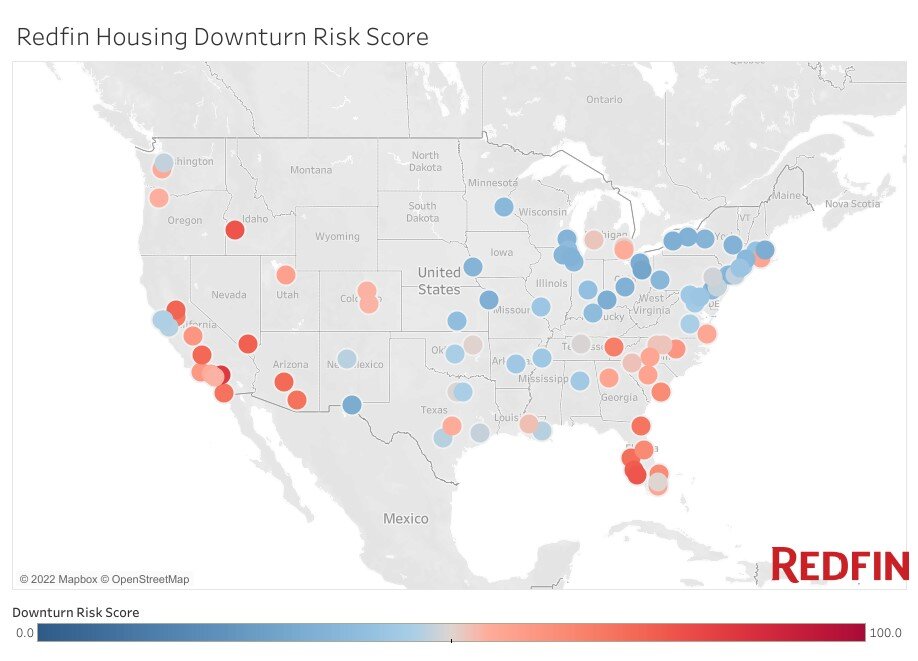Residential Real Estate News

U.S. Housing Markets with Steep Price Increases During Covid Most Susceptible to Housing Downturns in a Recession
Residential News » Las Vegas Edition | By Monsef Rachid | July 27, 2022 8:48 AM ET
Based on new research from national property broker Redfin, popular migration destinations where home prices soared during the pandemic are most likely to see the effects of a housing downturn amplified and home prices decline year over year if the economy goes into a recession. Redfin also found that relatively affordable northern metros are most resilient in the event of a recession.
The U.S. housing market also slowed considerably in the spring, with 5.5%-plus mortgage rates sending many buyers to the sidelines and cooling competition, said Redfin.
"Recession fears are escalating, mostly because the Fed has signaled it will continue to raise interest rates to tame inflation and cool consumer demand. Higher interest rates led to surging mortgage rates, which have already cooled down the housing market," said Redfin Senior Economist Sheharyar Bokhari. "If the U.S. does enter a recession, we're unlikely to see a housing-market crash like in the Great Recession because the factors affecting the economy are different: Most homeowners have a fair amount of home equity and not much debt and unemployment is low."
"But a recession-or even a continued economic downturn that doesn't reach recession levels-would impact some local housing markets more than others, and there are a few factors that put certain areas at risk," Bokhari continued. "First, what goes up must come down. Home prices soared at an unsustainable rate in many pandemic homebuying hotspots. Additionally, places where people tend to have high debt compared with their income and home equity are vulnerable because their residents are more likely to foreclose or sell at a loss."
Even in the most vulnerable parts of the country, most homeowners are likely to remain on solid footing, Bokhari said. Home values may drop from the peak they reached in 2021 and early 2022, but the decline is only on paper for homeowners who are staying put for at least a few years, as values typically increase over time.
Migration destinations with rapidly rising home prices are most at risk of a continued housing downturn
Riverside, CA has the highest chance of seeing its housing market cool further if the U.S. enters a recession. It has an overall risk score of 84, the highest of any major U.S. metro. That means a combination of housing and economic data indicate it's more likely than other metros to see prices decline year over year during a recession or continued economic downturn. Riverside, which spans from eastern suburbs of Los Angeles like San Bernardino and Ontario through the Palm Springs area, has highly volatile home prices and it was a hot destination during the pandemic, both for people permanently relocating and those buying second homes.
Riverside is followed by Boise (76.9), Cape Coral, FL (76.7), North Port, FL (75) and Las Vegas (74.2). Sacramento, CA (73.1), Bakersfield, CA (72.2), Phoenix (72), Tampa, FL (70.7) and Tucson, AZ (70.1) round out the top 10.
Like Riverside, many of those housing markets are popular migration destinations and/or places with rapidly rising home prices, both factors that are major contributors to their risk of suffering from a housing downturn. Additionally, Boise, Cape Coral, North Port, Las Vegas, Sacramento and Phoenix were all among the 20 fastest-cooling markets as of May, when mortgage rates approached 5.5%. That's an indicator that prices are more likely to drop in many of those metros as the economy continues to contract.
Six of the 10 areas most at risk of downturns are among the most popular destinations for Redfin.com users moving from one metro to another. Maricopa County (Phoenix) and Riverside County gained more residents from other parts of the U.S. than anywhere else in 2021, according to the U.S. Census.
The most at-risk metros have also experienced outsized price growth. North Port, where home prices increased 30.5% year over year in May, has the nation's fastest-growing prices, followed by Tampa (28.1%) and Las Vegas (26.8%). All in all, nine of the 10 most at-risk areas have faster-growing home prices than the national median (Sacramento is the exception, but home prices there did rise more than 40% during the pandemic, reaching $610,000 in May 2022).
Several of those metros moved from affordable to not-so-affordable during the pandemic, partly due to the influx of people moving in from other areas. Those include Boise, where the median home price grew from $330,000 to $550,000 from May 2020 to May 2022, and Phoenix, where it went from $300,000 to $485,000.
"Boise's market is already turning around, as a lot of the people who moved to Idaho during the pandemic are either moving back to their hometowns or cashing in and moving to more affordable places. The housing market was hot during the pandemic, largely because of out-of-town buyers," said Boise Redfin agent Shauna Pendleton. "Sellers are asking me if the cash buyers from California are still around, hoping they'll swoop in and offer to buy their home for more than the asking price-but that's not happening much anymore, and the cash buyers who are in the market are often offering below the asking price. I don't expect home values to plummet, but we do need to come down from the clouds at some point and sellers need to adjust their expectations to the new reality: There are more homes on the market, fewer buyers, and a higher chance that buyers can't pay the asking price because their monthly payments have shot up due to rising rates."
"But buyers have more to choose from, less likelihood of entering a bidding war and more time to make major financial decisions," Pendleton continued. "Even if higher rates mean buyers need to look at less expensive homes, they're still likely to get a better deal than a year ago because homes aren't being bid up way over the asking price. And if home prices do decline, more people will be able to afford homes in places where they may have been priced out at the height of the buying frenzy."
Relatively affordable Rust Belt metros are most resilient in the face of a recession
Akron, OH has the lowest chance of a housing downturn if the U.S. enters a recession. It has an overall risk score of 29.6, the lowest of any major U.S. metro. Some factors that make Akron relatively resilient are low home-price volatility, low debt-to-income ratio, relatively few second homes and the fact that homes there are unlikely to be flipped.
Akron is followed by Philadelphia, with an overall risk score of 30.4, Montgomery County, PA (31.4), El Paso, TX (32.2) and Cleveland (32.4). Cincinnati (32.6), Boston (32.6), Buffalo, NY (33.1), Kansas City, MO (33.4) and Rochester, NY (34) round out the top 10. Nearly all of those metros are affordable with relatively slow-increasing prices, both factors that would help their housing markets in the face of a recession. Prices rose slower than the national median in nine of the 10 most resilient metros (El Paso is the exception).
Seven of the 10 metros least at risk of a housing downturn had a median sale price lower than $300,000 in May, and in nine of them it's lower than the national median of $431,000. Affordability helps housing markets in a recession because it means people are more likely to be able to buy homes, and those places may attract people from out of town looking for lower prices.
Sign Up Free | The WPJ Weekly Newsletter
Relevant real estate news.
Actionable market intelligence.
Right to your inbox every week.
Real Estate Listings Showcase
Related News Stories
Residential Real Estate Headlines
- Las Vegas Area Home Prices Uptick 4.3 Percent Annually in March
- Single-Family Rent Growth in U.S. Trends Upward in 2025
- U.S. Mortgage Rates Tick Down Post Trump Tariffs Commencement
- President Trump's 'Liberation Day' Tariffs Potential Impact on the U.S. Housing and Mortgage Markets
- Baby Boomers Biggest Cohort of U.S. Home Buyers in 2025 as Millennials Decline
- U.S. Monthly Housing Payments Hit Record High in 2025
- U.S. Pending Home Sales Uptick in February
- Global Prime Residential Rent Slowdown Continued in Late 2024
- Ireland Home Price Inflation Hits 8 Year High in Early 2025
- Existing Home Sales in America Uptick in February
- Great Miami Area Residential Sales Decline 15 Percent Annually in February
- Mortgage Rates Uptick in Mid-March, Ending 9-Week Decline in U.S.
- World Property Ventures Builds the Future of Real Estate with New Funding Round
- U.S. Builder Sentiment Declines Amid Economic Uncertainty and Rising Costs
- Black Homeownership Rates in U.S. Enjoy Largest Annual Increase of All Racial Groups
- Wealthy Renters Are Taking Over More of the U.S. Rental Market
- If U.S. Congress Does Not Extend NFIP Soon, Thousands of Daily Home Closings Impacted
- U.S. Mortgage Applications Spike 11 Percent in Early March
- Greater Palm Beach Area Residential Sales Rise in Early 2025
- New Apartments in U.S. Are Leasing at Slowest Pace on Record
- U.S. Mortgage Rates Drop to 4 Month Low in March
- Overall U.S. Mortgage Delinquency Rates Dip in December
- New Tariffs on Canada, Mexico to Impact U.S. Homebuilder Input Costs
- Monaco's Property Market: A Tale of Two Cities
- U.S. Home Purchase Cancellations Surge, 1 in 7 Sales Getting Canceled
- U.S. Pending Home Sales Hit Historic Low in Early 2025
- Greater Miami Area Residential Sales Dip in January
- Governor DeSantis Supports Ending Property Taxes in Florida
- WPV Aims to Become the Berkshire Hathaway of Real Estate Tech
- U.S. Home Sales Slump Continues in January
- Average Americans Spend 38 Percent of Monthly Income on Mortgage Payments
- Switzerland's Safe-Haven Appeal Grows with World's Wealthy Homebuyers
- U.S. Builder Confidence Rapidly Declines in February
- Las Vegas Home Sales Rise 6.7 Percent Annually in January, Condo Sales Dip
- Homebuyer Demand in America Drops to 5-Year Low in Early 2025
- Ownership More Affordable Than Renting in Most U.S. Markets
- The World's First Global Listings Service Launches, Called a GLS
- Home Prices Continue to Rise in 89 Percent of U.S. Metros in Late 2024
- Global Luxury Residential Prices Showed Gradual Improvement in Late 2024
- U.S. Construction Hiring Rate Drops to Lowest Levels in 5 Years






